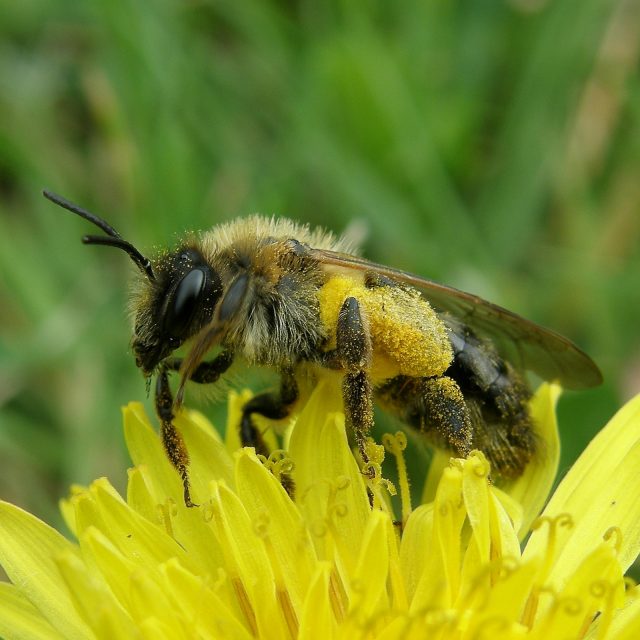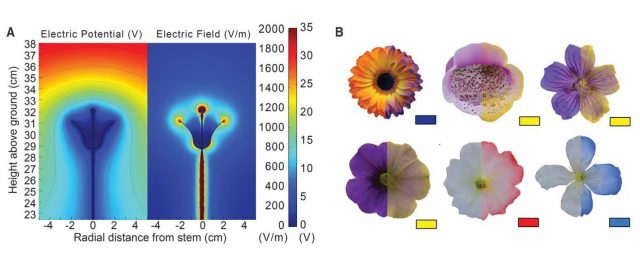On bees, antennae and (electrical) flower power

Bees visit flowers to obtain nectar (a sugary liquid) and pollen (their source of fat and protein). During foraging trips, bees do not choose flowers at random. For example, as first pointed out by Aristotle, bees visit only one type of flower in each of their foraging trips. How do bees recognise flowers? Colour textures, ultraviolet patterns in the petals of flowers, odours, local air humidity… bees can detect a wide range of cues and use them to decide whether to approach a flower. With adequate rewards in controlled experiments, bees can be taught to modify their preferences.
Surprisingly, electricity has a role to play when a bee is looking for its flower. In open air, during a clear day, there is a vertical electrical potential gradient of around 100 V/m. As a consequence, behaving just as lightning rods would do, the top and outermost parts of flowers get an induced negative charge. At the same time, air friction produces a build up of positive charges at least in flying insects. When a bee approaches the grounded flower, the animal electrostatically induces more negative charge on the plant. The resulting electrical field between the positively charged bee and the negatively charged flower is known to help pollen adhering to the insect.

In a recent report in “Science” 1, Daniel Robert and his colleagues from the University of Bristol publish evidence of bumblebees being able to detect electric potentials. The researchers also give a hint on how bumblebees may be using this previously unknown electrical sense to optimise foraging.
First, Daniel Robert and his colleagues measured net electrical charge in 51 individual bumblebees using a Faraday pail ―a shielded conductive container that allows for fine measurements of electric charges inside―. Extending previous studies in honeybee, they found that the great majority of the bumblebees (48) were indeed positively charged (fig 2A).
Next, they inserted an electrode in the stem of a flower (Petunia intergrifolia) to record potential changes in the flower during the landing of bumblebees. Each time a bumblebee landed in a flower, an increase in potential of around 20 mV was detected, followed by a slow decrease toward the resting potential (fig 2B). The increase in potential shortly precedes the landing of the bumblebee, an effect of the electrostatic induction that the approaching positively charged bee produces in the flower, grounded through the comparatively smaller resistance of the stem and roots.

When a bee visits a flower, it depletes the flower’s nectar for some time. To avoid being ignored in the future, it is in the interest of the flower to communicate to subsequent bees that there is no nectar left. Flowers transmit this information by changing colour, shape or humidity. However, these changes happen in the time-scale of minutes and hours, but the visit of a bee immediately produces a rise in electrical potential that can last up to 100 seconds. If another bee could pick up on this rise, it could use this ability to detect which flowers have been recently visited. Can bees do so?
To explore this hypothesis, the authors placed artificial flowers in an arena. They were all similar, except for the fact that some of them were held at a certain electric potential and carried a sucrose reward, while others were grounded, and contained a solution of quinine that bumblebees dislike. When the potential was 30 V, the bumblebees learned after 40 visits to approach only the charged flowers. During the final 10 visits, they landed 81% of the occasions on the charged flowers that carried the reward. When the scientists turned off the potential, the same previously trained bumblebees landed only half of the time in flowers with the sucrose reward, as they would do by chance. This shows that the bumblebees were not using other cues apart from electricity to detect the flowers carrying reward. Further experiments show that the learning period is shortened by the combination of other cues, such as hue.
Smaller potentials failed to elicit the same learning. In a similar experiment, bumblebees were unable to tell apart flowers when the flowers carrying a reward were connected to a potential of 10 V. Whether they can detect the even smaller changes in potential caused by the landing of another bee remains unknown, an interesting possibility that will guide further work.
How can bees detect electric fields? Electric fish use specialized ampullary receptors; platypus uses large sensory mucous glands found all over its bill. No specialized structure has been described in the bee so far. Some researchers think that bees may be doing so by detecting their hairs standing on end, not unlike what happens when you put your hand on the screen of an old TV set or you comb your hair. In a paper published in Proceedings of the Royal Society B 2, Randolf Menzel and his colleagues give evidence that honeybees may be using the mechanoreceptors in the joints of their antennae to indirectly detect electrical fields.

Menzel and his colleagues found that the charged bees, when performing their dance used to communicate a new food source, produce variable electrical fields with the wingbeat frequency of 230 Hz. When presenting the same electrical stimulus under laboratory conditions, a vibration in the tip of the antennae of an immobilised bee was detected (fig 3). Electrophysiology measurements of the mechanoreceptors in the antenna joints, showed that the mechanoreceptors were firing in phase with the presented electrical field. The researchers also performed behavioural experiments that show (independently from Clarke et al) that honeybees can react to electrical fields, and can associate a reward with either a constant and a varying electric field.
Previous work suggested that some insects such as cockroaches can detect electrical fields. However, these two recent articles emplace the use of electric interactions as a central possibility for communication between insects. Maybe some of them have antennae for reasons not that different from a radio set ones than previously thought!
References
- Dominic Clarke, Heather Whitney, Gregory Sutton and Daniel Robert “Detection and Learning of Floral Electric Fields by Bumblebees” Science 340 (6128), 66-69. (2013) DOI:10.1126/science.1230883 ↩
- Uwe Greggers, Gesche Koch, Viola Schmidt, Aron Dürr, Amalia Floriou-Servou, David Piepenbrock, Martin C. Göpfert and Randolf Menzel “Reception and learning of electric fields in bees” Proc. R. Soc. B 280 (1759) (2013) DOI:10.1098/rspb.2013.0528 ↩
2 comments
Interesting. Do we know how is produced the signal transmission in the brain of the bee and the parts of the brain involved?
[…] able to detect. These electrostatic fields can change when a bee visits a flower. This information allows bees to determine whether or not it is ´worth´ visiting these flowers where other insects fed previously, saving time and effort. Hunting […]